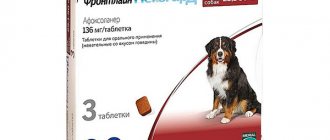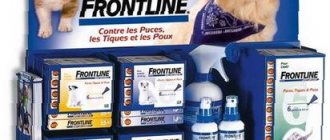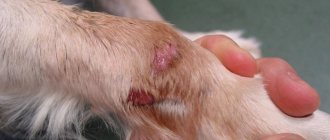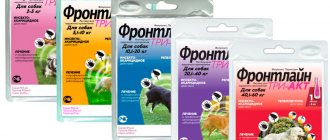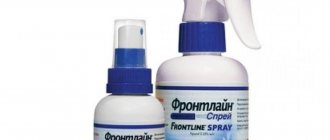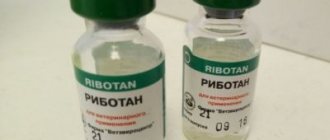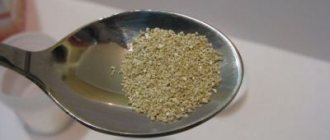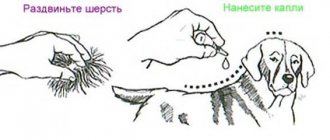With the arrival of warm weather, our smaller brothers, like people, are exposed to the attack of various insects. Fleas and ticks are especially nasty. These small-looking insects can be carriers of dangerous diseases, and fiddling with them every time is a thankless and dreary task. We’ll tell you how to quickly cope and prevent infection in our review. We have selected effective products for pets to enjoy outdoor recreation to the fullest.
Composition, features of action
Flea drops for dogs are intended for targeted application to the skin in places where the animal cannot lick it. The active component is fipronil. A new generation insecticide with a broad spectrum of action and a low toxicity class. Fipronil penetrates the flea's body through contact, partly through food. It disrupts the functioning of the nervous system, provokes paralysis, and death occurs within a few minutes.
The active components of Frontline drops act locally and do not penetrate the systemic bloodstream. Within 2 days after spot application, they are distributed over the entire skin and coat. Fipronil accumulates in hair follicles and sebaceous glands.
Important!
The effect of Frontline anti-flea drops for dogs lasts 3 months. After this, the drug loses its properties and is completely eliminated from the body. The effectiveness of the product is not affected by water procedures, but it is recommended to carry them out no more than once a week.
Instructions for use
So, there are different forms of the drug.
"Frontline" spray
The instructions say that it can be used to combat different types of pests: it will remove ticks, fleas, small parasites that cause scabies, and so on. Do not process in the apartment, it is better to go outside to inhale less of the specific smell of the medicine. Treat the fur against the growth line, massage the liquid a little into the skin. It is best to wipe the muzzle with a moistened cotton swab to avoid irritation. The dosage depends on the weight and length of the cat or dog's fur. It is determined by the number of clicks, and it is different for bottles with different capacities. Three dozen sprays of a 100-ml bottle, for example, would be the ideal amount for a short-haired five-kilogram animal. In general, this is 3 ml per kilogram of weight. You can also read the reviews: “Frontline” in the form of a spray is recommended not only by owners, but also by doctors. This drug is practically safe even for small kittens or puppies over two days old! After treatment, make sure that the pet does not lick the still wet fur. Do not wash it for another two days after using the medicine. When should the treatment be repeated? Not earlier than a month if you kill ticks. For other pests, wait 3 months.
"Frontline" drops
This form is often recommended for dogs. The package contains one ampoule-pipette, easy to use. There are separate pipettes for different weights of dogs, so the dosage is easier here. Break off the plastic tip of the pipette. Apply the product between the shoulder blades, spreading the fur. Over the course of a day, it will spread over the skin and be absorbed into the animal’s glands. In this case, only the ticks will be harmed. Repeat the course of treatment with the same frequency as when using the spray form.
Terms of use
Frontline drops against fleas
Instructions for using Frontline drops for dogs are extremely simple, but certain rules must be followed:
- Dog animal processing is allowed indoors, but it must be well ventilated.
- You should work with drops using rubber gloves. Immediately after the procedure, wash your hands with soap.
- After treatment, the dog should not be allowed outside in rainy weather for at least 2 hours.
- It is forbidden to pet the dog for two days.
- If an allergic reaction occurs on the skin, you need to wash off the drops with water and soap. An alkaline environment neutralizes the action of the insecticide.
Important!
Dogs should be re-treated for fleas after 3 months. It is forbidden to reapply drops if the owner thinks that the drug did not work.
According to Aibolit's recipe
Of course, you can buy the necessary antiparasitic medicine without a prescription - the same “Bars” will cost you several times less. Bearing in mind that some drugs are more expensive only because of promotion, and the filling of ampoules is often the same, you can choose this proven product. Perhaps some drug was recommended to you by friends. But are they right for your pet? Now Frontline is recognized as one of the best drugs. For cats and dogs, in the form of drops or in the form of a spray - the ideal option will be chosen for you. The most convenient one, of course, is Frontline spray. The instructions are on the package, but it would be a good idea to discuss the dosage with your doctor. Your pet may need less parasite spray, but probably not more.
special instructions
The active components of Frontline drops do not enter the systemic circulation, which reduces the likelihood of side effects. However, a local irritant reaction in the area where the product is applied is possible, manifested by redness, burning, and itching.
Frontline drops on the withers for dogs
In the presence of individual intolerance, the following is observed:
- loss of appetite;
- vomit;
- increased salivation;
- lacrimation;
- irritability or apathy;
- drowsiness, insomnia;
- body trembling, spasms.
In most cases, unpleasant symptoms disappear on their own within a few days. If this does not happen, you should seek help from specialists.
It is forbidden to use drops on puppies under 8 weeks of age, sick or weakened pets. Frontline is allowed to be used during pregnancy and lactation, but with special control from the owner.
On a note!
Puppies up to 8 weeks of age are allowed to use another Frontline spray to protect against fleas. The drug is applied to the fur and practically does not come into contact with the skin. The same treatment option is recommended for adult dogs with hypersensitive skin.
Frontline flea and tick spray
When you need to choose a flea remedy for a very small kitten, there is not much choice. Most anti-parasitic drops and collars can only be used from two months of age. And Frontline spray - from two days.
Place of purchase, price
A 100 ml spray was purchased at a pet store, the price was about 1000 rubles. A 250 ml spray is also available, but it costs more - about 1,700 rubles.
Frontline spray as it is
What Frontline spray should do:
Kill all fleas within 24 hours, protect against fleas for up to 4-6 weeks.
How to use:
Based on the weight of the animal, calculate how many presses will be required. The table on the Frontline website will help. Before use, shake the Frontline Spray bottle thoroughly and, holding it vertically, press the spray head and direct it onto the surface to be treated from a distance of 10-20 cm. Spray the entire body of the animal against hair growth, slightly moisturizing the fur (in animals long-haired breeds, the hair is lifted by hand). Covering the animal's eyes, treat the ears and chest, and lightly rub the drug around the eyes and nose with your fingertips.
The instructions are hidden under the label right on the bottle itself:
Full instructions for use can be found here.
The smell of the spray is strong and kittens really don't like it. They get scared and it becomes difficult to hold them back to continue spraying.
Spray in action
Kitten No. 1, lives in a private house
After the first treatment, there seemed to be no fleas on the kitten for two or three days. But then we noticed first one on the chin, and after a couple of days there were already several.
When two weeks had passed, we decided to process it a second time. The kitten is short-haired, weighs less than 1 kg, but we sprayed it quite a bit: six pumps, in several places throughout the body. But no matter how it was, new fleas appeared even faster than the first time.
Kitten No. 2, lives in an apartment
We used the spray a few days after the kitten was bathed with flea shampoo. Some of the fleas then died, but the kitten was still itching.
Since the kitten is black, fleas are hard to see on it. At first, after processing with Frontline, it seemed that they were not there. But after a week or two the kitten began to itch again. We bathed him again and removed a bunch of fleas - even more than the first time.
What Frontline itself says about this:
More than a day has passed since the Frontline treatment, but I still see fleas on my pet, how is this possible?
If you still see fleas or flea droppings on your dog, cat or ferret after treatment, it's natural that the first thing you think is that the flea medication isn't working. But, like many things in our lives, treating a flea infestation is not as easy as it seems! Modern flea treatments, such as Frontline, do not work as repellents, but are effective in killing newly arrived fleas within 24 hours.
The life cycle of these parasites is such that the fleas that are noticeable on your pet are only a small fraction of the total flea population. 95% of fleas in various stages of development, such as eggs, larvae and pupae, hide in the external environment where the animal lives. New fleas can attack your pet at any time from an infested environment. This is why it is normal to see a few fleas on an already treated animal. It may take up to 24 hours to kill each new flea. It's impossible to tell fleas apart, so it's easy to think the product isn't working when in fact Frontline Combo continues to kill fleas - each time you just see a different flea that will die soon. To completely get rid of fleas, it takes some time (sometimes up to three months).
Okay, in a private house there are places for fleas to come from. We can assume that they jump on the kitten again. But it’s strange that there are no fewer fleas on the apartment kitten if they supposedly have to die within 24 hours. When bathing, large fleas were washed away, clearly not newborns. The apartment is after renovation, there are no carpets, the kitten was the only source of fleas.
Let's give Frontline another chance
Three months have passed. I saw a flea on a black kitten. We decided to treat it again with Frontline spray, especially since there was a lot of it left. They could produce smaller bottles so that it would not be excruciatingly painful for the money spent. For several hours after treatment, the kitten ran around as if scalded - apparently, he was bitten by fleas. But whether they bit him in their death throes or simply because they were outraged that someone had spoiled their air is unclear.
The next day I noticed a dead flea on the kitten. But this was the only evidence that this spray was working, because the kitten was still itching. I think if you give him a bath, the picture will be the same as during the last bath.
It feels like only those fleas that are immediately suffocated by the suffocating Frontline die. We did not see any signs that it accumulated in the sebaceous glands of the skin, as it should, and had any lasting effect.
I didn’t think it would be so difficult to find good flea protection for little kittens. Our adult cats always wore Beaphar collars and knew no grief. But collars from the same company for kittens, in our experience, are rather weak. Fortunately, kittens grow quickly, and soon it will be possible to find some kind of drug that actually works.
Is it worth paying more?
With all the hype and popularity of the drug, one should not forget what made it so powerful. Yes, yes, it's all about the active substance. In the drug "Frontline" it is fipronil, obtained quite recently. The essence of its action is that it affects the GABA channels of insects, interfering with the passage of chlorine ions. As a result, the pest's nervous system collapses and it dies. At the same time, it does not harm the mammal. According to official data and reviews, Frontline can cost from four hundred to one and a half thousand rubles, depending on the characteristics. But the prices for other drugs with the active ingredient fipronil are much more affordable: from one hundred rubles.
Customer reviews: Is Frontline not the same anymore?
Of course, this drug would not be so popular among dog and cat owners if it were not for its excellent quality. All its advantages have already been said: safe, effective, applicable to almost all animals. However, what can we notice when looking at reviews? Front Line is increasingly losing its effectiveness. Some animals, instead of getting rid of ticks, acquire other diseases that seem to be unrelated to the original problem. It's all about the manufacturer. France is considered the best. Polish and Russian medicines are noticeably inferior in quality. And yet, four stars out of five invariably accompany customer reviews.

